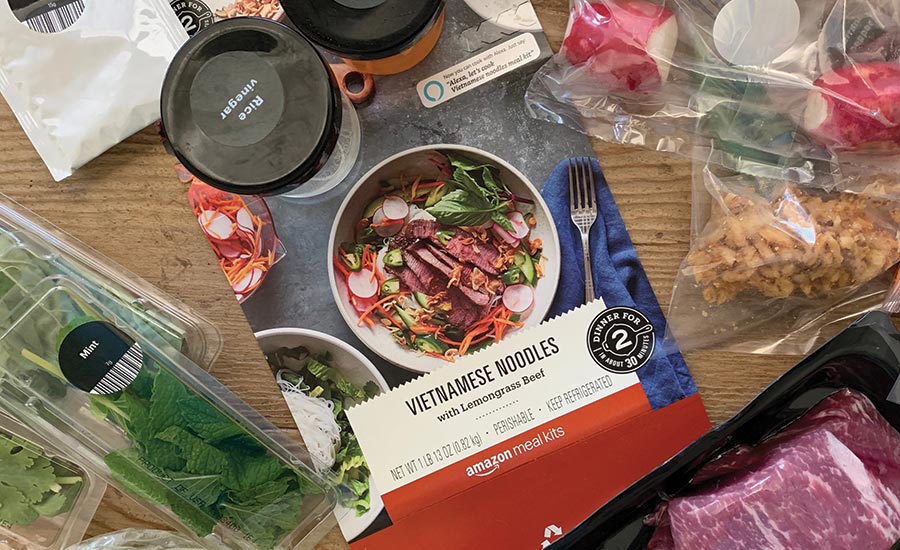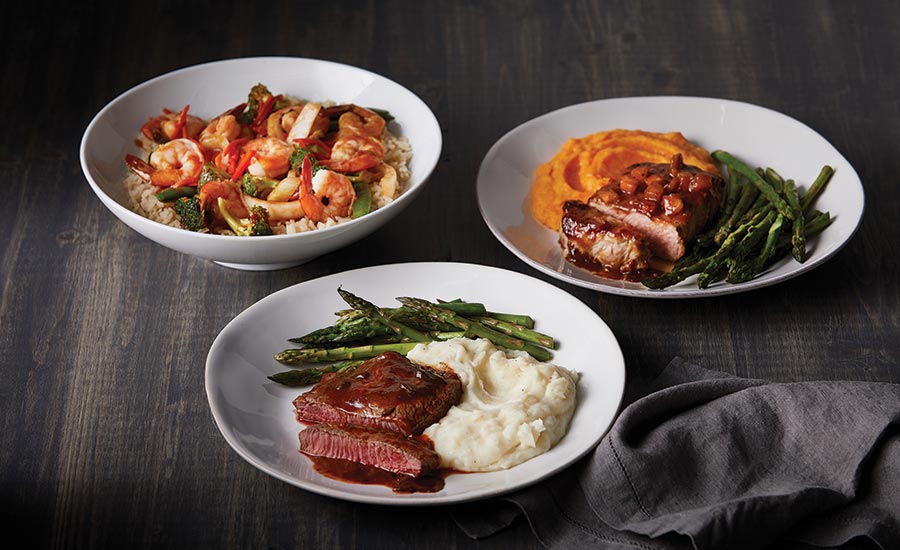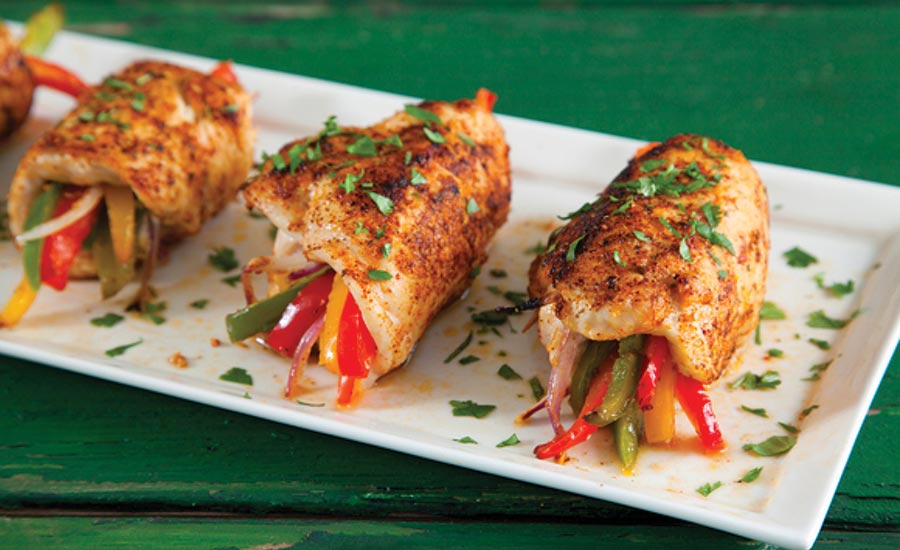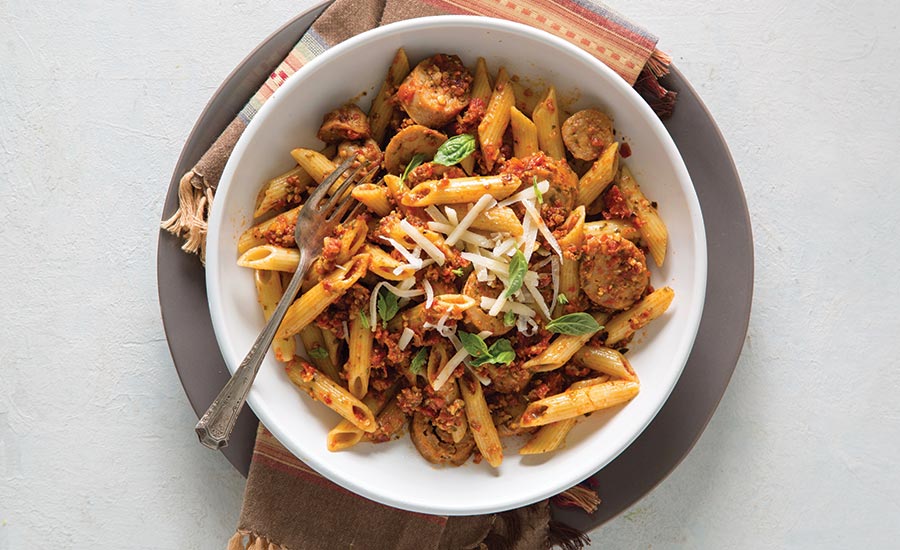Examining Meal Kit Consumers
Fit to Kit: An increasing number of consumers are avoiding cooking meals at home — by cooking meals at home
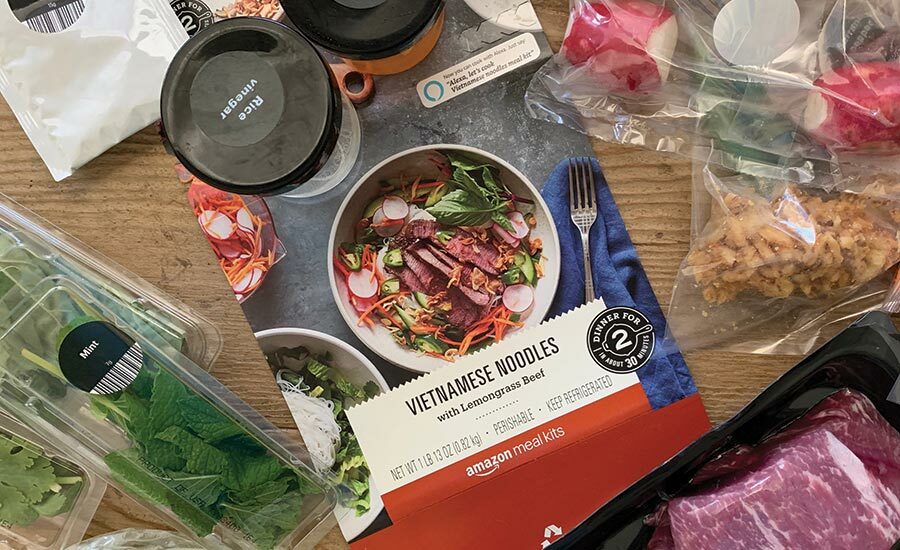
The meal kit industry is bringing a new generation of consumers back into the kitchen.
PHOTO COURTESY OF: shutterstock/ designs by Jack/Amazon.com, Inc.

Meal kits can not only help save busy families time and money but provide options that allow for special dietary needs.
PHOTO COURTESY OF: The Fresh Market, Inc. (www.thefreshmarket.com)

The cross-cultural pollination of global cuisines is getting an extra push via meal services that offer authentic ethnic dishes.
PHOTO COURTESY OF: Good Food Holdings, Inc./Metropolitan Market (www.metropolitan-market.com)

Successful meal kits have easy-to-follow instructions that allow even beginning home chefs to prepare attractive, restaurant- quality meals quickly and inexpensively.
PHOTO COURTESY OF: e-Meals, Inc. (www.emeals.com)

Some kits require the consumer to apply finishing touches yet still make the result feel like a homemade dinner.
PHOTO COURTESY OF: The Fresh Market, Inc. (www.thefreshmarket.com)

Many meal-kit services are at the cutting edge of trends, offering options such as plant-based animal protein analogs.
PHOTO COURTESY OF: E-MEALS, INC. (WWW.EMEALS.COM)

The cross-cultural pollination of global cuisines is getting an extra push via meal services that offer authentic ethnic dishes.
PHOTO COURTESY OF: Good Food Holdings, Inc./Metropolitan Market (www.metropolitan-market.com)







Whether assembling kits themselves at a local meal kit assembly shop, signing up for a subscription service online, or picking up a kit from their local supermarket, consumers show no signs of abandoning this time-saving meal option.
The consumer research group Nielsen reports that currently, the average meal kit consumer is affluent, with an income above $100,000 per year. In 2018, this demographic increased its purchase of in-store meal kits by 9%. Consumers aged 35-44 are also heading to the grocery store for meal kits and showing similar growth in purchases. With this added point of distribution and consumers’ continued demand for fresh, fast, and easy — yet nutritious — home-cooked meals, demand is only expected to continue to rise.
Meal kits are fresh, prepped, and pre-measured ingredients assembled to create a meal for two to four people. Why are they so popular? They offer the consumer something everyone needs more of: time.
Delivery meal kit services mean no trip to the store, little to no prep time, no food waste, minimal clean-up, and the opportunity to try new foods without forking out a ton of cash. Meal kits also provide variety and balanced nutrition, with some companies offering meals tailored to special dietary needs.
The meal kit industry is still experiencing some growing pains. Online delivery services have dominated the meal kit market over the past few years, with mixed reviews. Early players who made a big splash on the scene have been shooting stars; others have been unable to grow beyond their immediate geographic area.
In navigating a typical meal kit company’s website, consumers select their meals for the week and receive their kits via rush delivery services. While this is the optimum in convenience, these meals are usually slightly more expensive than the self-assembly option.
Customization options are limited as online meal kit service providers struggle to attract enough labor to assemble standard meals, let alone consider customization. In addition, there is the concern about food safety. Regulations around shipping standards are nearly non-existent at this point, and the risks involved in shipping fresh food via common carriers are plentiful.
Emerging Paradigms
New to the meal kit game, and possibly the image of its future, are the retail grocers that have entered the arena. Such supermarkets do so by either developing their own programs or partnering with successful online meal kit services. For example, The Kroger Co. recently acquired Home Chef, one of the meal kit success stories. The company, founded in 2013, delivers some three million pre-portioned ingredient kits with recipes every month.
Walmart Inc. plans to roll out meal kits this year, and online retail goliath Amazon now sells meal kits on its website. In addition to Home Chef’s partnership with Kroger, other successful meal kit companies have opted to begin working with retail grocery chains to establish a brick-and-mortar presence.
Plated Co. has teamed up with Albertsons Companies, Inc. (which owns Safeway, Vons, Tom Thumb, Jewel, and other major supermarket chains); Blue Apron, LLC, has joined forces with Walmart (and Weight Watchers as well); and HelloFresh SE (owned by the German venture capital group Rocket Internet SE) — now the largest service of its type in the US — has affiliated with Ahold Delhaize USA, owner of the Giant, Food Lion, and Stop & Shop chains as well as the Peapod grocery delivery service.
Simple and Safe
The meal kit is more than just a time-saver. It is a means by which consumers can bring their families together, learn to cook, and explore new ethnic cuisines. With this in mind, it’s crucial to know the end-users and their needs. Developers should keep instructions clear and simple, recognizing that many of today’s meal kit consumers might be preparing such an item for the first time. Avoid lofty culinary terms, build food safety measures into instructions, and assume nothing when it comes to ensuring that the consumer is preparing not just a delicious meal but a safe and wholesome one as well.
The Fresh Market, Inc., emphasizes the reduction of food waste — a global epidemic — as a side benefit to its meal kit service. The health-oriented, produce-centric grocery chain describes its meal kits as “all-in-one meal solutions for two, ready in 20 minutes or less.”
The kits, sited in the chilled produce section, feature the premium ingredients offered by each store, so selections have variety and can highlight freshness. Would you like wine with that? The Fresh Market also provides wine pairing suggestions to accompany each meal.
This pairing of meal kits and supermarkets appears to be the shot in the arm the category needed. In-store meal kit users increased by 2.2 million households in less than a year, accounting for 60% of growth in that channel. Total sales of retail grocery meal kits in all of 2019 reached $93 million.
With price points for retail meal kits being roughly the same per serving as online meal kit services, shoppers can grab one or two kits at a time to work into their regular routine, instead of committing to a week’s or a month’s worth of meals. Moreover, concerns about food safety, variety, and quality are significantly lessened in brick-and-mortar retail, where customers have established trust with a local grocery store.
Kit-Making Strategies
Good Food Holdings, Inc.’s Metropolitan Market, an upscale grocery store serving the Puget Sound, Washington, area took a “wait and see” approach to deciding if and when to enter the meal kit market.
“Being first to market with meal kits was never our goal,” says Dan Osser, Metropolitan’s food service coordinator and meal kit developer. “We were able to take a look at the market research on what style of kits were selling before creating what we felt would work best for our customers.”
Osser describes the ingredients and techniques that went into meal kit development for the chain: “When we launched the program, we wanted to include a good variety of products, and to make sure that the menu mix regularly changed. To that end, we always include a combination of chicken, pork, vegetable, and beef dishes. Finding the right mix was a challenge, and we ultimately settled on a rotating list of our best sellers over a guaranteed variety in protein options.”
Osser continues, “The meal kits on the market that have the most success and staying power are the ones that can be put together very quickly. The programs that require a lot of work for the customer are more likely to burn those customers out. They might try one of the cook-from-scratch kits a few times, but then they will lose interest once they realize how similar it is to preparing dinner the ‘old-fashioned’ way.” The fast meal kits Metropolitan constructs offer home-cooked meals that already are semi-prepared. They create the true shortcuts to cooking that consumers prefer.
This is a key consideration for those entering into the meal kit milieu: how much prep is just enough for the average home cook? Of course, all meal kit shoppers must be willing to commit to some level of prep, but the spectrum is broad, ranging from a few quick and simple acts such as snipping chives over mashed potatoes to the “from scratch” kits that are essentially providing the recipe and doing the shopping.
Metropolitan Market settled on designing meals that could land on the consumer’s table in either 15 or 30 minutes. This involved two completely different approaches. “Our 15-minute meal kits demand that everything be pre-chopped, pre-marinated, and — for many ingredients, such as meats — pre-cooked,” explains Osser. “For our 30-minute meals, we did decide to include raw meats, but the cuts must be small enough to cook quickly.”
Developing recipes for this dual platform comes with its own particular set of challenges. For example, since meal kit choices are ever-changing, there’s a need for a constant flow of new, exciting dishes from the test kitchen. Then, there’s finding the right balance of speed, variety, quality, and ease — and doing so twice for each recipe.
Thinking Inside the Box
by Dan Osser, food service coordinator and meal kit developer for Metropolitan Market supermarkets
A rather large “pain point” with meal kits is packaging. Kits are typically made up of a lot of small bags, jars, bottles, and containers that, for the most part, end up in the trash. One way to overcome this concern is by using reusable items that the consumer can add to their kitchen equipment. This option assumes, however, that the consumer is in need of such items.
Metropolitan Market took a different approach. We really wanted to be as sustainable as possible with our packaging. Compostable packaging on meal kits is not the standard by any means, being more expensive and often leaky. However, it was important for us to limit our single-use plastics as much as possible. Much of our packaging is compostable or recyclable.
Compostable packaging manufacturers are making strides in stability and strength. That means a wide variety of recyclable packaging options are available for the producer who is interested in taking that “green” route.
For animal proteins, other packaging issues arise. In some cases, grocery stores might find union and USDA issues with packing meat in their central commissaries if they do not already have USDA certification. For Metropolitan Market, this meant getting creative and involving multiple departments. The solution we came up with was to assemble all ingredients but the meat, then send the kits to stores. At that point, the meat and seafood departments could cut and add in the raw meats. This resulted in extra work for our meat and seafood teams, who had to then unpack and repack each box.
Special Consideration
Consumer demographics play a huge part in choosing your target meal kit end-users’ decision point. If your target consists largely of health-conscious consumers, your strategy might dictate that you follow the tenets of the paleo or keto diets.
In determining what meals to offer, Metropolitan Market studied customer meal favorites in addition to its research into the current state and details of the meal kit landscape. “We did a great deal of research into the bestselling options in other competing meal kits, but ultimately the decisions on the final recipes came down to our staff testers,” says Osser. “With each new recipe, we assemble several test kits to send home with our staff. Then, we use their feedback to come up with the final menu.”
In some cases, Osser has been able to translate customers’ purchases from the stores’ prepared foods cases into meals that shoppers can make in their own kitchens. “We brainstormed popular take-out meals for ideas and some of our favorite home recipes for others,” he says. “With Metropolitan Market already in the retail deli foodservice business, many of our concepts already were being prepared in house. We then deconstructed those meals and recreated them to conform to simple cooking instructions.”
A huge consideration for a newly launched meal kit program is the ability (or willingness) to portion foods in small packages. For smaller grocery chains, this can mean more labor. “Since we assemble everything from scratch, yet in relatively small numbers, we have to hand-pack pouches of inclusions such as nuts, seeds, and spices, or of sauces or marinades,” concedes Osser. “Larger companies can contract out those tasks or have them done by machines.”
For those starting a program at relatively low unit output numbers, labor cost will be high at the beginning. But as production increases, the number of kits per hour a manufacturer can produce will increase, and time-saving measures will become easier to apply.
Larger retail grocery companies can have greater buying power and the ability to meet the minimums required by the manufacturers of all of the smaller components that make meal kits complete and competitive. So, labor considerations may not be quite as significant.
School is in Session
The team at Metropolitan Market decided to combine time savings with education. “Early on, we had to determine what style of meal kit to do,” explains Osser. Metropolitan settled on a “we prep, you cook” style to conform to its goal of 15-30 minutes maximum cooking time. “Our research suggested this would be the best for our customers,” says Osser. “While convenience is a huge factor, education is an important one as well. We want to have kits that allow the customers to assemble a homemade meal quickly, while at the same time learn a new cooking technique.”
Osser notes that it is essential to consider every aspect of the home cooking experience. He strives to keep prep for the consumers light: no unscrubbed potatoes, unpeeled garlic, or anything that potentially could be a mess. When there is chopping involved, it is kept simple and easy. “One skillet meals or one sheet pan meals are winners for our time-conscious customers,” he adds. “Be considerate of how messy the kitchen will be after the meal is complete. If it takes 15 minutes to cook, it shouldn’t take more than 15 minutes to clean up.” Osser also suggests developers consider adding in steps that kids can help with, and to mention that in the recipe.
Regardless of the style of kit a developer wishes to create, all ingredients need to be those that hold up well in pre-chopped, sliced, or portioned form. Foods with short shelf lives will pose a problem, especially if the offerings are typically a week’s worth of meals. For example, pre-chopping highly delicate and perishable herbs like cilantro will not allow for a shelf life of more than a day or so. Such ingredients need to be provided in whole form for customers to chop themselves.
Another draw to the meal kit for consumers is the opportunity to learn about new cuisines without the expense of a multicultural pantry. “There are definitely ingredients we employ that might not be found in the average home kitchen.” Osser says. “We discovered a pattern to the most successful kits, and many included some of the more exotic ingredients.”
Such meal kits from Metropolitan include everything from daikon radish, miso paste, and capers to Thai basil, maifun noodles (very thin dried rice vermicelli), lemongrass, galangal, kaffir lime peel, fish sauce, mojo marinade, and Japanese peppers. He notes that the combination of exotic and easy makes for a popular meal kit. Osser cites as a classic example a stir fry Pad Thai dish that comes together quickly and easily for customers, while being fun to create and serve.
In the Works
One of the US’s largest and most successful meal-kit companies is e-Meals Inc. Structured as a “meal assembly service coordinated with both retailers and delivery services,” it describes its offerings as “curated meal plans,” and connects consumers and food brands to the online grocery pickup and delivery services of Walmart, Amazon, Kroger, Shipt and Instacart. The service currently caters to more than 1 million families, helping to “relieve the daily stress of putting healthy home-cooked meals on the table quickly, easily and affordably.”
According to the company, “Subscribers have access to 15 food style meal plans, each with new weekly dinner ideas that can be mixed and matched from plan to plan.” Customers select meal choices via the eMeals app which then automatically converts it into a grocery list. The customer may then shop off that list at the participating supermarket or — with a single click — have the ingredients delivered by the grocery retailers or assembled and ready for pickup.
Metropolitan has found its success with kits that engage customers in simple preparation. For example, a meat and potatoes kit seasoned simply with a measured amount of salt and pepper continues to be one of the company’s best sellers. Osser attributes it to the fact that the customers appreciate the convenience aspect of everything being cut and portioned and measured.
Still, fresh food is king in the world of meal kits, and this presents the greatest challenge to meal kit makers. Fruits and vegetables — especially apples and pears, potatoes, eggplant, and mushrooms — all oxidize rapidly and develop unpleasant textures or an unattractive appearance shortly after they’ve been cut.
In some cases, even specific species of certain fresh vegetables will present such challenges over others. For example, fresh Persian cucumbers have a very short shelf life of no more than two days and so have to be substituted with hardier cucumber varieties.
But this is where the marriage of meal kits with brick-and-mortar retail sites offers considerable advantages. In the case of Metropolitan Market, the ability to have a substantially reduced concern about lengthy shelf life allows it to maintain meal kits that have a shelf life of only a few days once they’re assembled and distributed to stores.
“Our decision to offer 15- to 30-minute kits with pre-cut vegetables and pre-marinated meats decided the shelf life for us,” admits Osser. “The vegetables in many of the kits are also pre-marinated, which makes them ready to stir right into a hot pan. We’re able to send kits three days per week to keep them fresh and keep an eye on movement to decrease shrink.”
Still, even copious research and testing can’t guarantee success, especially in the currently volatile meal kit arena. “It was very easy to come up with concepts, but we were all surprised by some of the best sellers,” admits Osser. “Some of the development team’s absolute favorite kits just didn’t sell on the shelf.”
Meal Kits in Foodservice
Reser’s Fine Foods put the “kit” in kitchen—at the restaurant level.
By Bob Garrison, Chief Editor
Consumers aren’t the only ones who need a little help in the kitchen. Others seeking greater convenience, freshness, and efficiency include food handlers working in restaurants, institutional cafeterias, and even catering companies. These are just the operators targeted for a new salad kit line from Reser’s Fine Foods in Beaverton, Ore.
The five varieties of these salad kits are: Broccoli (pictured, right), Seafood, Chicken Caesar Bow Tie, Loaded Baked Potato, and Curried Chicken. The refrigerated kits come two-per-case, have a shelf life of 15 to 45 days (depending on variety), and can be prepped in just minutes before serving.
“We developed the line to provide more opportunity to have a great dish, without taking a lot of effort involved in the restaurant or letting produce go bad,” says Sean Dwigans, Reser’s chef and culinary manager of research and development. “A lot of the salad kits from produce companies need to be used right away to keep them fresh, but our kits can be made to order. Since they don’t need to be used right away, it’s a lot more convenient and reduces an operator’s fresh produce waste.”
The kits especially serve catering applications, because they’re easy to make as needed. They also are great for college or corporate kitchens where speed, flavor, and visual appeal are high priorities. Moreover, the kits don’t require skilled labor to prepare. Each case comes with easy-to-follow instructions. “Since it often is hard to find staff with experience in the current tight labor market, our kits help alleviate the pressure of needing to hire more highly trained kitchen staff—but still produce great looking and tasting meals,” adds Dwigans.
Dwigans also notes that complexity of the kits varies. Reser’s Loaded Baked Potato Salad Kit is all-inclusive and does not need additional produce. It comes with a container of potato salad base and packets of baked-potato toppings, including bacon and shredded cheddar. The Broccoli Salad Kit, on the other hand, requires the operator prepare and add the raw broccoli and red onion. There also is room for operator creativity.
The Seafood Salad Kit serves as a customizable base, where operators can add their own ingredients. It includes a pack of surimi and shrimp as well as a container of dressing, allowing the assembler to create anything from a salad to a wrap sandwich. The Chicken Caesar Bow Tie Salad Kit can be similarly customized. It comes with a container of cooked pasta, a package of grilled chicken, a package of dressing, and package of cheese. Because spinach is added by the operator as the kit is assembled, staff may use arugula, romaine, or a similar leafy green instead.
According to Dwigans, the freshness of the ingredients are such that the kits may be prepped as far as two days in advance. “All of the components stay separate, keeping the produce crisp; the nuts, seeds, and other such inclusions or toppings truly crunchy; and colors and flavors of various ingredients from bleeding into each other and turning unappealing — something that can happen when you include ingredients such as cranberries,” he explains.
The kits are quick to mix — none takes more than five minutes to prepare — and there’s no need to dirty a lot of equipment to prepare them. “It’s just a bowl, spoon and serving plates—and that’s it,” says Dwigans.
Looking for a reprint of this article?
From high-res PDFs to custom plaques, order your copy today!







